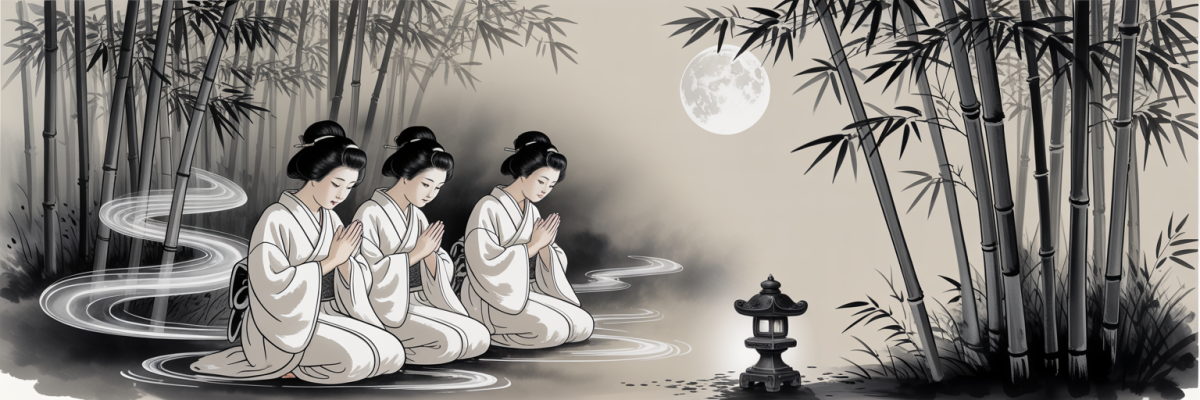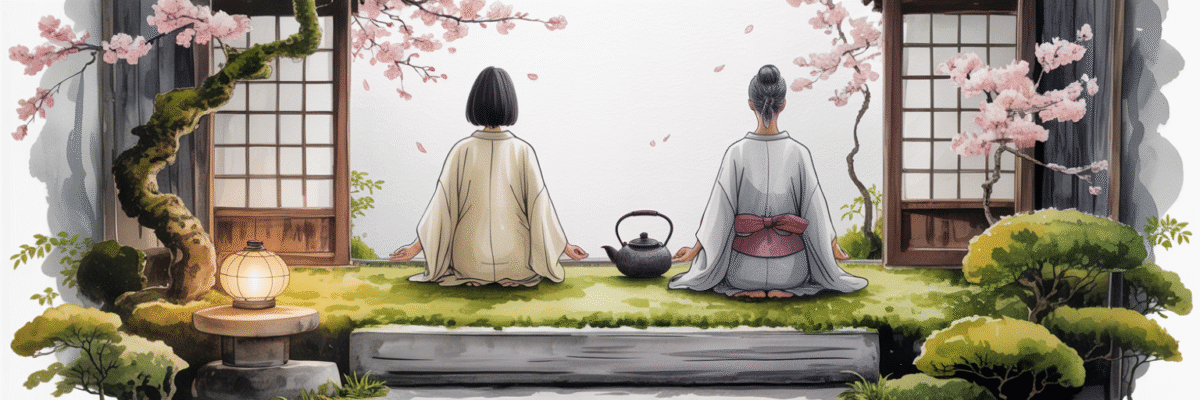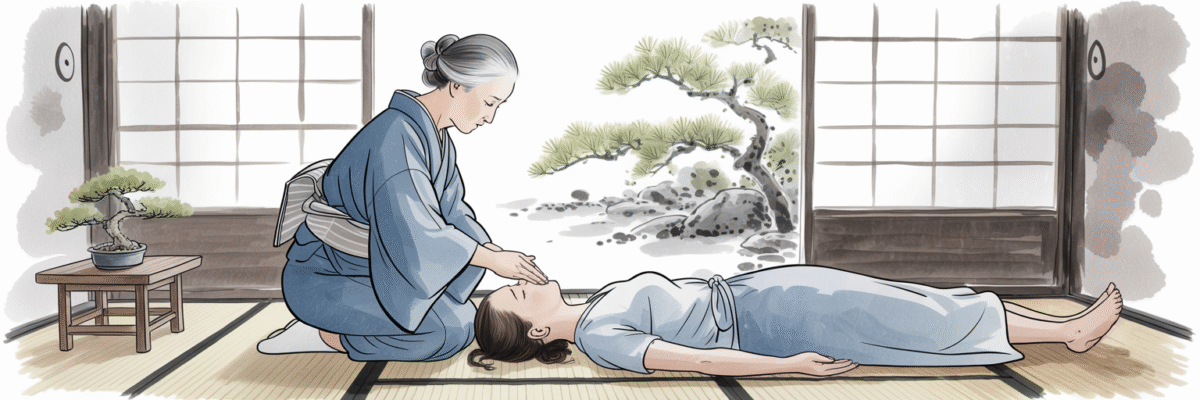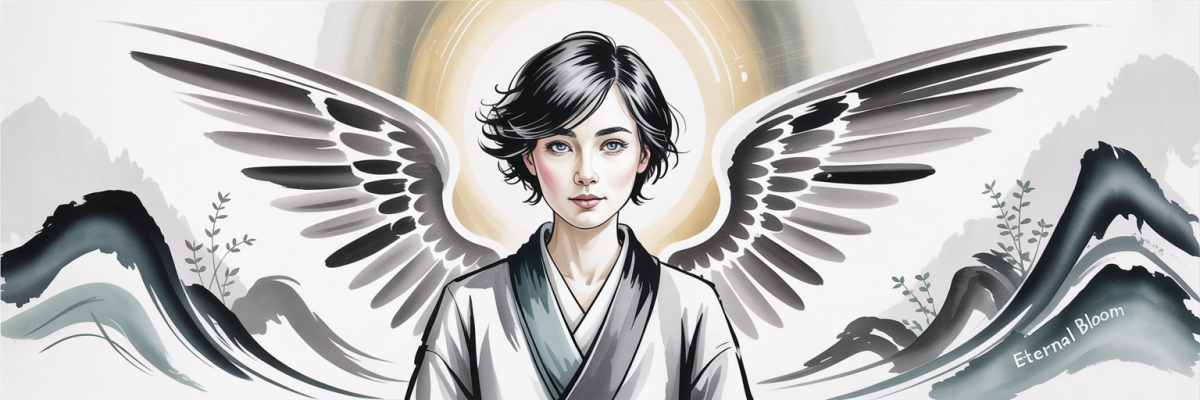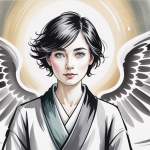
I Am an Angel
June 8, 2025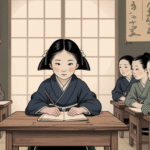
Do We Ever Feel Like We Belong?
September 15, 2025Poetry?
Imagine, it’s the early 1900s in Japan. You peer through a bamboo forest to a clearing where a group of Reiki practitioners, lit by a full moon, sit serenely with their hands raised in gasshō meditation. As you come closer you realise they are reciting rythmnic words. It is waka—traditional Japanese poetry that carries the spiritual essence of their practice, their culture and their imperial heritage.
Poetry? You ask yourself. What does poetry have to do with Reiki?
This practice, so fundamental to Mikao Usui’s original teachings, has largely been forgotten in contemporary Reiki practice. Yet, as we gain access to beautiful new translations of Emperor Meiji’s and Empress Shoken’s poems through Harold Wright’s dedicated work, we have the opportunity to reconnect with this unique aspect of Reiki practice.
Why Early Practitioners Embraced Waka
The Cultural Foundation
At the turn of the 20th century, Japan was emerging from 250 years of national isolation with a renewed cultural identity deeply rooted in traditional arts. Waka—composed of exactly 31 syllables arranged in the pattern 5-7-5-7-7—represented far more than ornamental poetic expression.
Waka as Sacred Spells
The spiritual power attributed to waka has deep historical roots in Japanese understanding. From the 12th century onward, waka were believed to be dharani—sacred spells that could achieve supernatural effects. As documented by Shintō scholars, “Waka came to be seen as Japanese-language spells infused with the same magical powers that characterised the dharani and mantra of esoteric Buddhism—and, indeed, waka served as such spells in medieval Shintō and Shugendō traditions.”
This wasn’t metaphorical—waka were understood as functional spiritual technology equivalent to Sanskrit mantras. When Usui included 125 imperial waka in his system, both he and his students recognized these as empowered spiritual tools, not merely inspirational poetry.
The Memorial Stone Evidence
The foundational importance of waka in the system of Reiki is literally carved in stone. Usui’s memorial stone, created by his students just one year after his death, states: “Thus, before teaching, the ‘ikun’ (admonition or teachings) of the Meiji Emperor should reverently be read and Five Precepts be chanted and kept in mind mornings and evenings.”
Memorial stone translator Hyakuten Inamoto confirms that “ikun” refers specifically to the Emperor’s waka poetry, these were his teachings, his way of bringing spiritual awareness to his people. Through Shintō belief, the Emperor was seen as the earthly representative of divine will – semi-divine rather than fully divine. His spiritual authority made his words (including his poetry) carry sacred power.
This establishes that imperial waka weren’t optional cultural elements but were so fundamental to Usui’s system that they warranted permanent commemoration alongside the Five Precepts as essential practice for Reiki practitioners.
Usui’s contemporaries confirm this understanding. Eguchi (a student and friend of Usui) described the waka component of his healing practice as “thought guidance” (shisō zendō), echoing the official Ministry of Education term for moral instruction. Imperial waka weren’t poems that happened to contain wisdom—they were recognized as sacred teachings issued by divine authority. Eguchi Toshihiro and his collaborator and waka author, Mitsui Kōshi, expanded this into a comprehensive system where waka served alongside dietary practices and energy techniques as their complete spiritual training. Including waka in spiritual practices in the early 1900s wasn’t aesthetic appreciation but engagement with what was considered formal spiritual pedagogy.
Author Kaiji Tomita, another student of Usui, documented how practitioners would “become One with the essence of the poem” during healing preparation, synchronizing their consciousness with the Emperor’s spiritual essence.
How We Can Benefit Today
Reclaiming Authentic Practice
Historical evidence reveals that waka recitation wasn’t an optional cultural addition to early Reiki practices—it was fundamental to how ki, or energy, was cultivated. Modern practitioners working with Harold Wright’s translations gain access to this authentic aspect of the practice. Wright, who studied under renowned Japanologist Donald Keene, was entrusted by the Meiji Jingu shrine with translating 311 poems by Emperor Meiji and 111 by Empress Shoken. Both these published works provide practitioners worldwide with new access to the teachings.
Universal Spiritual Principles
The poetry doesn’t require practitioners to adopt Japanese culture wholesale but rather to engage with universal spiritual principles expressed through refined artistic form. The universal themes in Emperor Meiji’s and Empress Shoken’s poetry—addressing perseverance in the face of difficulty, service to others, harmony with nature, and the cultivation of virtue—speak to human beings regardless of their cultural background.
Enhanced Consciousness and Energy Work
Contemporary research validates what traditional practitioners intuitively understood about poetry’s spiritual benefits. Studies have shown that engaging with meaningful verse can enhance mindfulness, self-awareness, and spiritual connection.
When practitioners recite these imperial poems regularly, they participate in a practice that research demonstrates can deepen contemplative awareness and promote the kind of present-focused attention that enhances healing presence.
Addressing Modern Spiritual Needs
Reiki practitioners today often struggle with questions about the spiritual authenticity and depth of their practice. Working with waka addresses these concerns by providing the following:
- Historical Grounding: Direct connection to documented practices from Usui’s era
- Spiritual Depth: Access to profound wisdom teachings embedded in poetic form
- Energetic Enhancement: Methods for cultivating greater amounts of ki
- Cultural Respect: Authentic engagement with Japanese spiritual tradition
Poetry can remind us that true healing emerges not from technique alone but from the cultivation of a pure heart, a clear mind, and a compassionate spirit.
Restoration, Remembrance and Respect
The re-integration of waka into Reiki practice represents, for many of us in the West, a new pathway into profound spiritual awareness.
It restores the system by allowing us to fully experience what it means to practice the authentic Japanese system of Reiki.
It is a bridge that brings us into a state of remembering with our authentic core through patterned ritual.
And it pulls us back into line with the teachings, offering the respect that a serious practice deserves.
In reclaiming both the poems and their traditional context, we restore an essential dimension to the system of Reiki that was documented as central to the original system’s success.
“Poetry has its seed in the human heart and blossoms forth in innumerable leaves of words… it is poetry which, with only a part of its power, moves heaven and earth, pacifies unseen gods and demons, reconciles men and women and calms the hearts of savage warriors”.
—Ki no Tsurayuki (884–946), from the preface of Kokinshū
Interesting reading:
Saigyō, famous Japanese waka writer and monk:
https://scholarsarchive.byu.edu/cgi/viewcontent.cgi?article=6306&context=facpub
Learn the authentic
Japanese Reiki practice
of Waka
Listen to a podcast about this subject:


